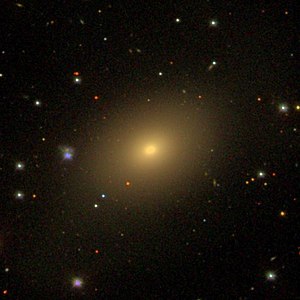NGC 5869
| Galaxy NGC 5869 |
|
|---|---|

|
|
| SDSS recording | |
| AladinLite | |
| Constellation | Virgin |
|
Position equinox : J2000.0 , epoch : J2000.0 |
|
| Right ascension | 15 h 09 m 49.4 s |
| declination | + 00 ° 28 ′ 12 ″ |
| Appearance | |
| Morphological type | S0 |
| Brightness (visual) | 11.9 likes |
| Brightness (B-band) | 12.9 mag |
| Angular expansion | 2.3 ′ × 1.6 ′ |
| Position angle | 125 ° |
| Surface brightness | 13.2 mag / arcmin² |
| Physical data | |
| Affiliation | LGG 393 |
| Redshift | 0.006955 ± 0.000013 |
| Radial velocity | (2085 ± 4) km / s |
|
Stroke distance v rad / H 0 |
(94 ± 7) x 10 6 ly (28.7 ± 2.0) Mpc |
| history | |
| discovery | Wilhelm Herschel |
| Discovery date | February 24, 1786 |
| Catalog names | |
| NGC 5869 • UGC 9742 • PGC 54119 • CGCG 021-022 • MCG + 00-39-006 • GC 4061 • H II 545 • h 1908 • LDCE 1076 NED044 | |
NGC 5869 is a 11.9 likes bright lenticular galaxy of Hubble type S0 in the constellation Virgo and about 94 million light-years from the Milky Way center.
It was discovered on February 24, 1786 by Wilhelm Herschel with an 18.7-inch reflector telescope, who described it as "pB, S, iE, lbM".
